Using Windows 7 Home Edition to Restore Professional
Repair your computer and protect your data:
- When need to perform Windows 7 boot repair command prompt?
- Run Startup Repair first with installation disc
- Boot Repair Windows 7 from Command Prompt | 5 Ways
- Useful tip: backup computer to greatly reduce data losses
- Summary
When need to perform Windows 7 boot repair command prompt?
If you have Windows 7 boot problems, the boot sector or master boot record on your system partition may be damaged, corrupted, or has missing files. And you will receive an error message like the following before Windows actually begins to load.
-
Error loading operating system
-
Missing operating system
-
Reboot and select proper boot device
-
Invalid partition table
-
Bootmgr is missing
-
FATAL: No bootable medium found! System halted.
Then, what are the boot sector and master boot record exactly?
The boot sector is a small section at the beginning of a hard drive. It's created when you format the hard drive.
The boot sector contains some code and data that helps BIOS hand off the startup process to Windows. It also hosts the Master Boot Record (MBR), which contains the disk signature, partition table for the disk, and a small bit of code called the master boot code.
When a PC starts, the BIOS will load the master boot code into the PC's RAM. Then it will scan the partition table, determine the active partition, load a copy of the boot sector into the PC's RAM, and hand off the startup process.
If you backup MBR in advance, you can use it to restore your computer and make it work as normal. If not, you can see the next part and learn to repair boot with command prompt in Windows 7.
Run Startup Repair first with installation disc
If your boot sector or MBR runs into problems, you cannot start Windows normally. That's to say, you need the Windows installation disc to boot your computer. If you don't have, you can create system repair disc or recovery disk on a working computer. Then, let's start with detailed steps below.
Step 1. Create Windows 7 installation media on a working computer. You can download ISO image files from Microsoft Store and burn the ISO image files to a USB drive or CD/DVD via Windows 7 USB DVD download tool.
Step 2. Plug the USB drive into your computer.
Step 3. Start your computer and press the corresponding key to go to BIOS.
Step 4. Set boot priority to your drive in the Boot option.
Step 5. Save changes and restart your computer. Then, you will see a black screen with error message like "Press any key to boot from CD or DVD...", just press a key in the keyboard. After that, it will star to load files, wait patiently.
Step 6. After that, you will go to the Install Windows screen, click Repair your computer.
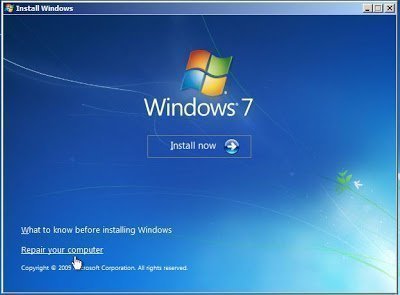
Step 7. Select the operating system Windows 7 in the System Recovery Options window and click Next. Sometimes, you will not see any operating system in this window, please click Load Drivers to install drivers for your disks.
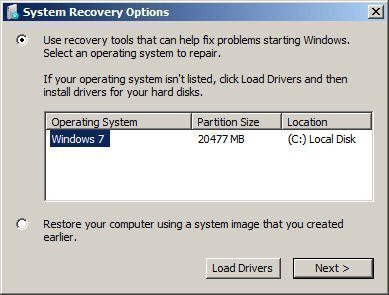
Step 8. Select Startup Repair in the System Recovery Options and it will automatically start to repair boot sector or MBR in Windows 7. Just wait patiently until the process is completed and click Finish.
Boot Repair Windows 7 from Command Prompt
When you try to manually run Startup Repair using installation disc, you may find startup repair not working sometimes and ask you to restore your computer with System Restore. Click Restore if you have a working restore point.
If not, click Cancel. Then, you will see the Windows cannot repair your computer automatically screen with 2 options at the lower location, select "View advanced options for system recovery and support". After that, you will go back to the System Recovery Options window and select Command Prompt to boot repair Windows 7.
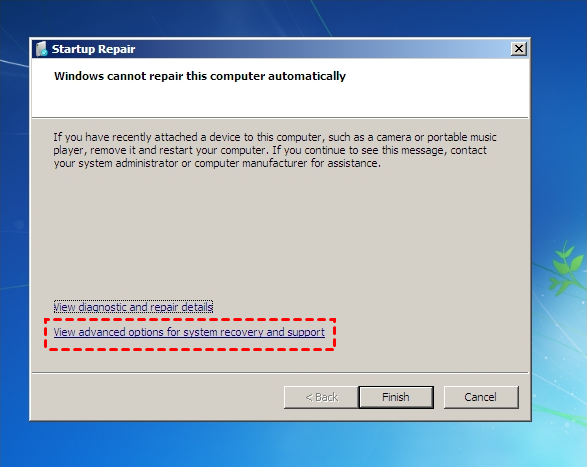
Also, if you don't want to perform Startup Repair, you can still open the command prompt window by pressing "Shift + F10" in the first Install Windows screen. Then, it will automatically pop up.
Wait a minutes, please try Windows 7 startup repair command prompt chkdsk to scan the integrity of your file system and hard drive so as to rule out the physical problem of hard drive. Because it can also damage the boot sector and MBR. Then, try other command prompt below.
- Way 1: Windows 7 boot repair with Bootrec
- Way 2: Repair boot sector in Windows 7 using DiskPart
- Way 3: Rename and rebuild BCD via NotePad
- Way 4: Rebuild BCD without notepad
- Way 5: Boot repair Windows 7 without disk
Way 1: Windows 7 boot repair with Bootrec
Step 1. In the command prompt window, type the following command line and hit Enter after each one.
- bootrec /fixmbr
- bootrec /fixboot
- bootrec /scannos
- bootrec /rebuildbcd
- bootsect.exe /nt60 all /force
Notes:
❤ The option /fixmbr is to fix MBR in Windows 7.
❤ The option /fixboot is to repair boot sector in Windows 7.
❤ The option /scannos is to fix bootmgr is missing in Windows 7 command prompt.
❤ The option /rebuildbcd is to rebuild your BCD and get the missing Windows installations back.
❤ Thebootsect.exe /nt60 all /force is to rebuild the boot sector for Windows. Among them:
>> The /nt60 parameter applies the master boot code that is compatible with BOOTMGR. The /all argument updates the master boot code on all partitions.
>> The /force parameter forcibly dismounts the volume(s) during the boot code update so that the Bootsect.exe tool does not gain exclusive volume access.
Step 2. Exit the command prompt window and restart your computer.
Way 2: Repair boot sector in Windows 7 using DiskPart
If the bootrec /fixmbr and bootrec /fixboot doesn't work, you can try to restore the boot sector code of your Windows 7 with steps below.
Step 1. In the command prompt window, type the following command line in order and then hite Enter.
-
diskpart
-
select disk 0
-
list volume
-
d:
-
cd boot
-
dir
-
bootsect /nt60 SYS /mbr
Notes:
❤ The command line from diskpart to list volume is to find the drive letter of your installation disc. Pleasae check the "Type" column which contains the word "CD-ROM", here take D: as an example.
❤ The command linebootsect /nt60 SYS /mbris to restore boot sector code using installation disc.
Step 2. Remove the installation disc and restart your computer.
Way 3: Rename and rebuild BCD via NotePad
If the above command prompt does not work for you, you still can try to backup and rename BCD first and then rebuild it via CMD.
Step 1. In the command prompt window, type bcdedit /export C:\BCD_Backupto create a backup for BCD.
Step 2. Then, type notepad in the command prompt window. Youw ill see a pop up window, click File > Open > Computer,find the BCD file and rename it as BCD.old. After that, save the change and exit this window.
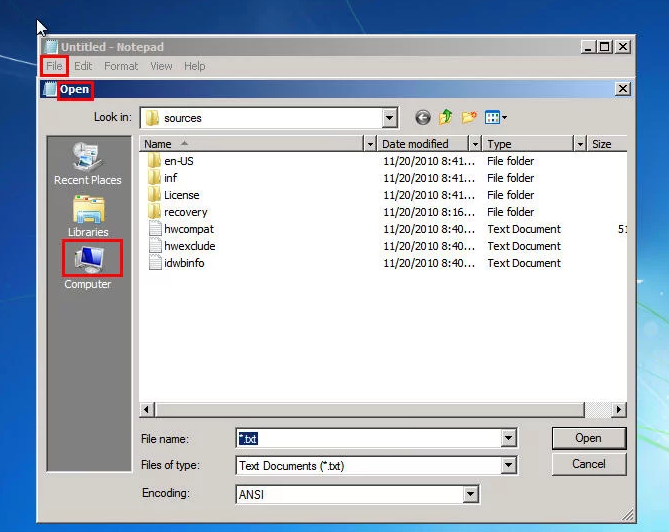
Step 3. Now, you will go back to the command prompt window. Type bootrec /rebuildbcd and hit Enter. Type Yes to confirm if you asked.
Step 4. Type bcdedit /enum all in the window. Then, hit Enter.
Step 5. Type exit and reboot your computer.
Way 4: Rebuild BCD without notepad
Step 1. In the command prompt window, type the command line below and hit Enter after each one.
-
bcdedit /export C:\BCD_Backup
-
c:
-
cd boot
-
attrib bcd -s -h -r
-
ren c:\boot\bcd bcd.old
-
bootrec /RebuildBcd
Note: c: refers to the location of your Windows.
Step 2. Exit the command prompt window and restart your computer.
Way 5: Boot repair Windows 7 without disk
Step 1. Turn on your computer, press and hold the F8 key to go to the Advanced Boot Options screen, then choose Safe Mode with Command Prompt.
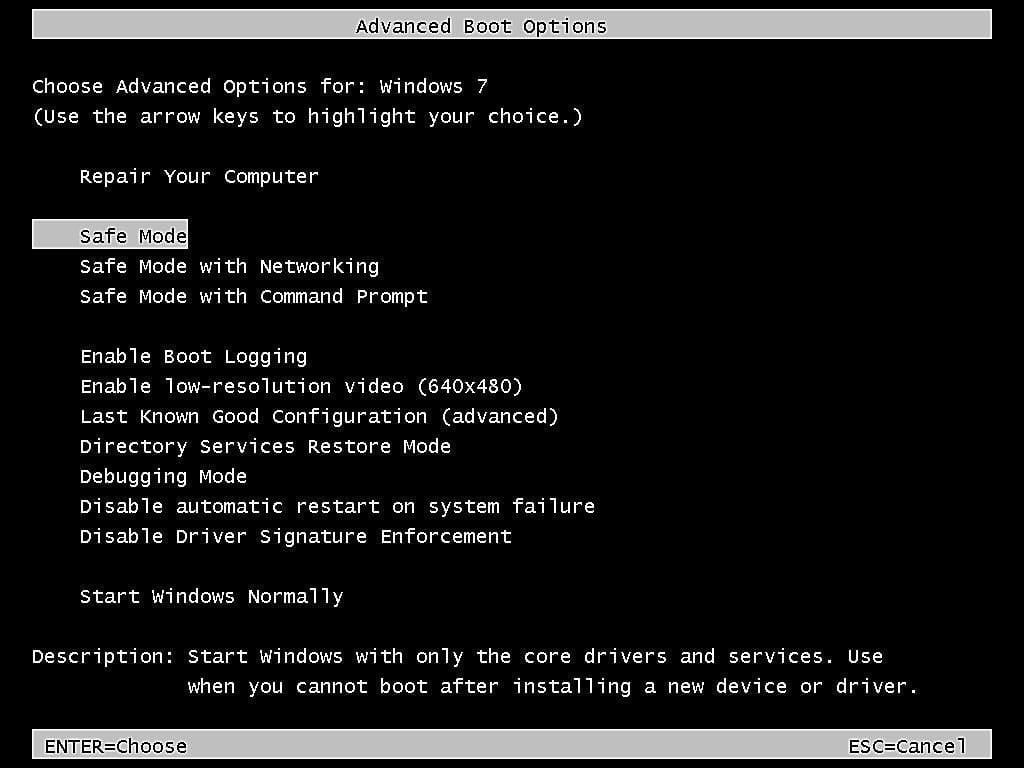
Step 2. You can try command prompt for Windows 7 boot repair above and see if it works.
Useful tip: backup computer to greatly reduce data losses
You never know when your computer will crash or becomes unbootable, thus it's suggested to backup system with a free backup software like AOMEI Backupper Standard. Here are some advantages of it.
- It supports 4 backup solutions. You can backup system, disk, partition, or files per your needs.
- It has 3 backup types. You can choose to create a full backup every time or backup only changed files with incremental or differential backup.
- It provides users with multiple schedule backup. You can backup at a regular basis, such as, daily, weekly, monthly. Also, with the help of the feature "Wake the computer to run scheduled task", it is able to wake your computer 2 minutes before the scheduled task starts.
- It supports Windows 11/10/8/7/XP/Vista.
In addition, its advanced edition has more useful features, such as, Event triggers, USB Plug in, etc. For server users, you can directly download AOMEI Backupper Server edition.
For IT Technician, you could use AOMEI Backupper Technician. It allows you to create portable version of this software and use it on any computer without installing. It's very convenient for IT maintenance and support engineers.
To backup your computer, you can download the backup software and open it. Then, click Backup,select System Backup and follow on-screen instructions to backup your computer. Also, you can choose other backup types.

Then, when something unexpected happens, you can go to the Restore tab and select the created image to restore system to new hard drive and then boot from it.
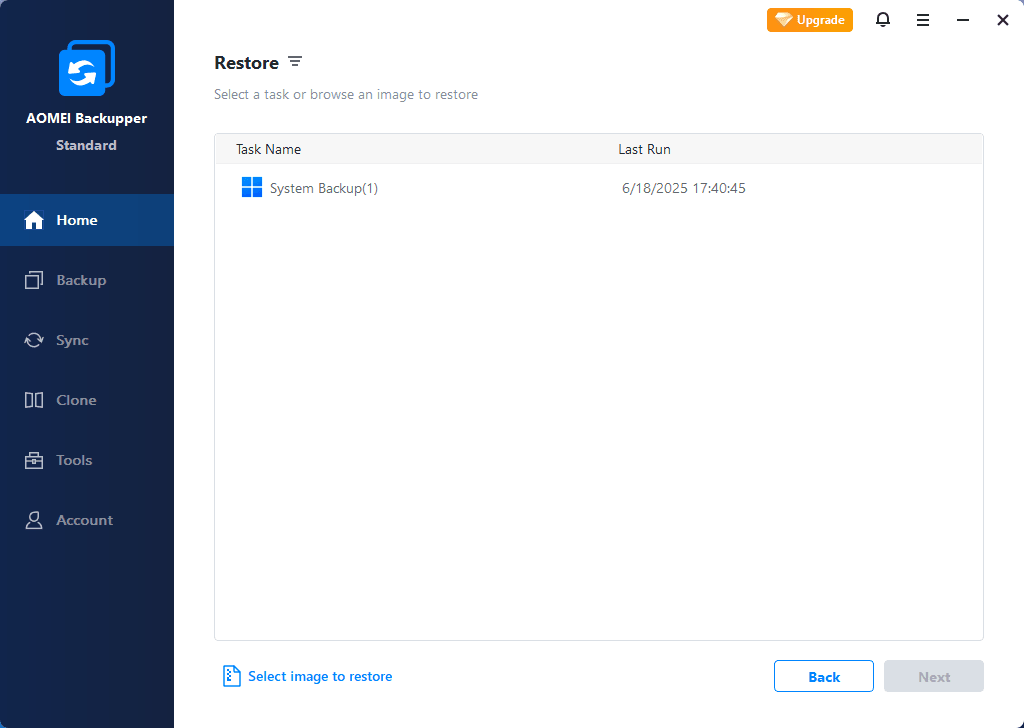
Notes:
❤ If your computer cannot boot, you can create a bootable media on a working computer and boot the computer having trouble. If you have multiple computers, you could consider using PXE boot tool.
❤ If you restore system image to different computer with dissimilar hard drive, you need to enable "Universal Restore" feature. It's available on the professional version of AOMEI Backupper.
❤ For IT maintenance and support engineers, you could use its Technician edition, which allows you to copy AOMEI Backupper to a removable device so that directly run it on target computers without installing
Summary
If you receive the above mentioned error message, the boor sector or MBR may be corrupted or damaged. You can use installation disk to run Startup Repair or boot repair Windows 7 via Command Prompt.
If you can repair boot with command prompt in Windows 7, you are very luck. But, sometime, you will fail to repair startup issue. To ensure the security of your data and your computer, you'd better to create a system backup or disk backup in advance. Then, you can restore system image or disk image in the event of a disaster.
Using Windows 7 Home Edition to Restore Professional
Source: https://www.ubackup.com/windows-7/command-prompt-windows-7-boot-repair.html
0 Response to "Using Windows 7 Home Edition to Restore Professional"
Post a Comment